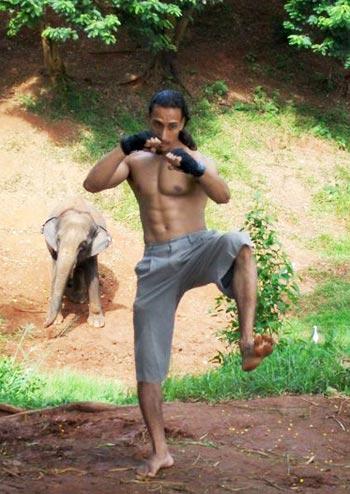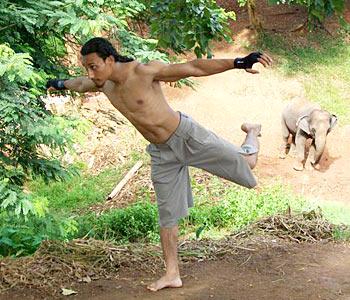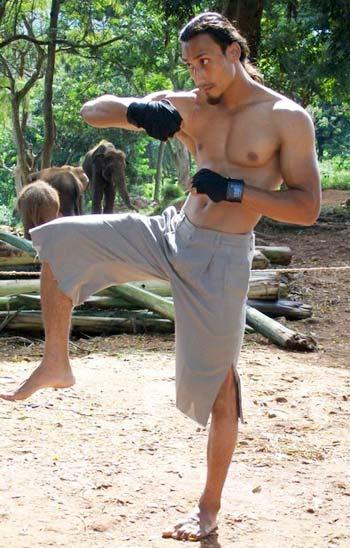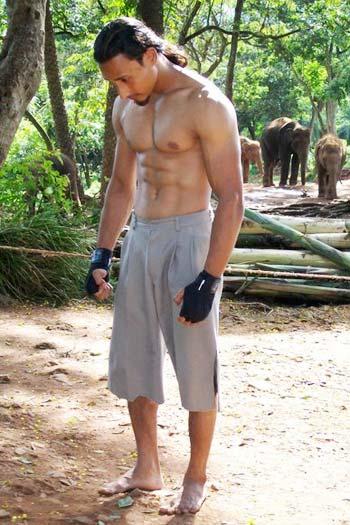
Wai Khru is an extremely graceful dance form of traditional Muay Thai (Thai kick-boxing). It is practiced for several reasons, one of the primary ones being to show that strength and grace should go together in a warrior. The Wai Khru (loosely, it may be translated to mean 'salute to the teacher') is performed before a contest between two equally pitted warriors and is offered in thanksgiving to all those, particularly the teacher, who have contributed to making the warrior what he is. Earlier, it is said, that the dance was also performed by the victor after the contest, but this practice has now been discontinued.
It is said that Wai Khru also helps establish the school of training of a warrior. But the movements, though graceful, are also extremely challenging. This is deliberate, to show off the complete control the warrior has over his body.
Here, Muay Thai instructor Biki Bora shows you a few movements from his own Wai Khru sequence. These poses may be tried independently, to develop your sense of balance, muscular co-ordination and strength. However, traditionally, these are done in a continuous flow and you may loop the movements into a graceful sequence for your own training.
The series on kick-boxing is co-ordinated by yoga instructor Shameem Akthar. For more on Biki Bora's health and kick-boxing tips visit bikiboxing.blogspot.com
Disclaimer: Any fitness regimen has to be tailored to individual needs for which you must work in tandem with your trainer and dietician. This series only provides broad guidelines.

Stand up with the left leg bent at the knee, learning to shift the weight to the supporting right leg. Left foot toes are pointed upwards, as shown. Making fists with either hand, place left hand slightly in front, while the right fist is close to the nose in what is traditionally referred to as the guard position. The left hand, as weaker hand, is usually placed in front for quick jabs. The left leg is also placed in front for the same reason.
Hold this position for as long as you can. Then release to land left foot on the ground in front, while you simultaneously bend the right leg at the knee, bending foot to point toes upwards. Now, standing on your left leg, hold the pose for as long as you can. You can move ahead or around in this fashion to complete a graceful set.
Benefits: Develops muscular coordination, strength, stamina, will-power and immense ability to balance.

Stand up straight. Bend left leg behind, at the knee. Spread out arms at shoulder-level. Tilt torso a little forward as shown. Look straight ahead. Shift the weight completely onto the right leg, straightening as much as possible. Hold the pose. Then, landing the left leg behind, without resting, repeat the entire move for the right leg.
Benefits: Develops mental focus, leg and arm strength, balance and muscular coordination.

Stand straight. Shifting weight to the right leg, bend left leg behind, at the knee. Make fists with both hands and hold the right hand towards the face, with the left fist towards the chest. Hold this final position for as long as possible. Then, landing the left foot behind, repeat the sequence for the opposite side.
Benefits: Same as previous pose, more enhanced.

Stand straight. Make fists with both hands. Bend the left leg at the knee, lifting it up, keeping it flared firmly to the left side of the body. Bend the left arm at the elbow, holding the left straight out, parallel to the left thigh. Right leg should be straight, taking the entire weight, while the right fist is held at chest level. Look ahead. Hold the pose for as long as is possible. Land the left foot back on the ground, then repeat for the opposite side.
Benefits: Develops hip strength and flexibility. Same benefits as previous poses, more enhanced.

The final finishing position for each dance sequence is different. However, before a contest, traditionally -- as in the yoga of breath (swar yoga) -- the fighter checks the flow of either nostril by placing his hands before his nose. He begins the movement from the side of the dominant (flowing) nostril. For instance, if his right nostril is flowing, he places his right foot forward while going ahead.
The direction of the body or face should also always be towards the east. In oriental science, this is the direction which you face to keep the mind alert.